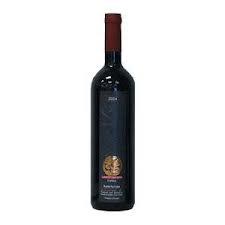A review of Bazelet Hagolan Cabernet Sauvignon 2009 and Jim Beam’s Devil’s Cut 90 Proof Kentucky Straight Bourbon Whiskey.
By Joshua E. London and Lou Marmon
Washington Jewish Week September 5, 2012

The varied geography of Israel’s Golan Heights region offers many locations with nearly ideal wine-grape growing conditions. Several wineries are located in the Golan, while others merely source their grapes from the area and truck the fruit down to their winery.
In 1998, Yoav Levy and Assaf Kedem established Bazelet Hagolan winery on Moshav Kidmat Tzvi in the central Golan Heights. Bazelet means “basalt,” a rock formed by the cooling of iron-rich lava released by ancient volcanoes. It underlies much of the Golan and, along with the high altitude and weather, is a major contributor to the flavor profile of the grapes.
Bazelet Hagolan initially produced only Cabernet Sauvignon but in 2006 they released their first Merlot. The winery became kosher in 2004 and Assaf has since moved on to start his own winery. However the quality of the wines has not suffered through these changes, and the winery remains among the top Israeli boutique producers. They release their wines as a “Reserve” which sees longer oak aging, and the earlier-drinking “Bazelet” which is also known as “Bronze.” And for those who enjoy grappa, their version is very tasty.
Aged for eight months in French and American oak, the mineral-laced Bazelet Hagolan Cabernet Sauvignon 2009 begins with dark berry, cedar and dried fruit aromas that expand into rich pepper accented blackberry, cocoa, currant and tobacco flavors in this medium-bodied, nicely balanced delight. It is an ideal choice for a holiday brisket.
Spirits-wise, with the High Holidays and 10 days of repentance rapidly approaching, we thought we’d consider Jim Beam’s Devil’s Cut 90 Proof Kentucky Straight Bourbon Whiskey (45 percent abv; $24).
The Beam name is legendary in bourbon, and not just because of its heritage. The Beam family has dominated the world of Bourbon whiskey, mostly as distillers and whiskey craftsmen rather than as businessmen or distillery owners, throughout its history.
Johannes “Jacob” Beam (1770-1834) of Pennsylvania (the family name Boehm was changed to Beam soon after emigrating from Germany) started the Beam Bourbon story in 1795. He had moved to the wilderness that was to become Kentucky in the late 1780s, and by 1795 was said to have begun selling his own whiskey. One of Jacob Beam’s grandsons was Colonel James Beauregard “Jim” Beam (1864-1947) – the Jim Beam. Jumping ahead through a long distinguished list of Beams, we get Frederick (“Fred”) Booker Noe III, great-grandson of Jim Beam and seventh-generation Beam distiller for the Jim Beam brand. All of which is a long-way round to saying that the Beam family has been making Bourbon whiskey from the beginning, and continues today at various, even competing, distilleries. All are known for producing excellent Bourbon.
The new Jim Beam Devil’s Cut was created by Fred Noe. The name is a clever play on the “angel’s share,” an industry term for the whiskey lost to evaporation in the course of warehouse maturation. During this maturation process, the whiskey is pulled in and out of the wood over time as the oak expands and contracts. Some of this whiskey simply remains leeched into the wood even after the barrel has been emptied (“dumped” in whiskey parlance) for bottling. The Beam trademarked term “devil’s cut” refers to this whiskey that was leached into the wood during maturation.
Typically, whiskey producers rinse their freshly dumped barrels with water to extract as much of these dregs as possible. Beam has developed a system to extract more of this than mere rinsing can achieve, and then harnessed this wood-trapped whiskey to, as it were, enhance their regular bourbon. In this case they use it to enhance 6-year Jim Beam bourbon.
All Beam’s marketing material will say is that, “through a unique, proprietary process, we extract this formerly lost liquid from deep inside the barrel wood and put it back into our special Bourbon.” But the inspiration for all this is actually brilliantly simple, and involves little more than Fred Noe reaching back into his childhood in Bardstown, Ky. There is a time honored-local rite of passage called “sweating a barrel,” enjoyed by local kids with “access” to bourbon barrels.
The ritual is straightforward. First, unofficially visit a local distillery, “liberate” a whiskey barrel that has been freshly dumped, and into this pour a few gallons of water, then plug up the bung hole to reseal. Second, these hooligans roll the barrel around, basking in the warmth of the hot sun and the implicit danger of having done something naughty. They play with it until the boredom sets in. The resulting liquid usually has just enough booze in it to give a pleasant buzz.
Beam uses a methodical variation of this “sweating” but is essentially the same principal: pour in water, mechanically agitate the barrel under controlled conditions, and extract probably 5 or 6 times more booze than a simple rinse. Add this “whiskey extract” to aged bourbon, and presto change-o you’ve got a “new” approach to making bourbon taste older than it is. This is truly innovative, brilliant stuff. Here’s our review:
Jim Beam’s Devil’s Cut 90 Proof Kentucky Straight Bourbon Whiskey (45 percent abv; $24): this lovely, deep golden yellow, complex, balanced, velvety whiskey delivers clean and intense aromas and flavors of vanilla, coconut, brown sugar, malty cereals, toasted tannic oak, burnt orange rind, honey, butterscotch, caramel, cinnamon, nutmeg and some lovely, creamy buttery note which balances the sweetness. The finish provides an additional light fiery bite amidst a mellow glow. With a drop of water, the creaminess is kicked up a notch. L’Chaim!
